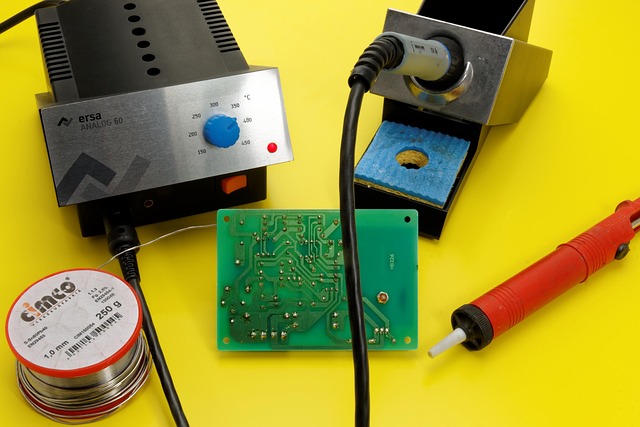Mercedes High-Strength Steel Repair: Verifying Integrity Before and After
Mercedes high-strength steel (AHSS) repair poses unique challenges due to its complex properties, re…….
Welcome to an in-depth exploration of a specialized yet pivotal aspect within the automotive industry—Mercedes high-strength steel repair. In the pursuit of enhanced vehicle performance, safety, and durability, manufacturers have turned to advanced materials and innovative repair techniques. This article aims to dissect and demystify the process, highlighting its historical evolution, global impact, economic implications, technological breakthroughs, regulatory landscape, and future prospects. By delving into these facets, we will provide readers with a comprehensive understanding of why Mercedes high-strength steel repair is not just a technical procedure but a strategic imperative in modern automotive engineering.
Mercedes high-strength steel repair refers to the specialized process of restoring and reinforcing vehicle structures utilizing high-tenacity steels (HTS). HTS, characterized by their exceptional strength-to-weight ratios, are integral to modern car bodies, offering enhanced crashworthiness and rigidity. The repair process involves several critical steps:
The concept of high-strength steel repair in automobiles traces back to the early 1980s when automakers sought to address growing safety standards and lighter vehicle requirements. Traditional low-strength steels, while affordable, lacked the necessary rigidity for more stringent crash tests. This led to the introduction of HTS, which offered improved strength without significantly increasing weight.
Over time, Mercedes-Benz, known for its luxury and engineering prowess, embraced HTS repair as a key component in building safer and more efficient vehicles. Their dedication to precision and quality control set a benchmark for the industry. As global safety standards evolved, so did the sophistication of HTS repair techniques, leading to more intricate and complex repairs.
Mercedes high-strength steel repair has left an indelible mark on the global automotive landscape. Its widespread adoption can be attributed to several factors:
The implementation of Mercedes high-strength steel repair varies across regions:
| Region | Adoption Rate | Primary Drivers | Notable Automakers |
|---|---|---|---|
| Europe | High | Stringent safety regulations, focus on sustainability | Volkswagen Group, BMW, Tesla (for its European models) |
| North America | Moderate to High | Improved safety standards, lightweighting initiatives | General Motors, Ford, Tesla |
| Asia-Pacific | Growing | Increasing demand for fuel-efficient vehicles, government incentives | Toyota, Honda, Hyundai |
| Latin America | Low to Moderate | Economic considerations, local manufacturing focus | Volkswagen, Fiat Chrysler (local operations) |
The global HTS repair market is characterized by:
The Mercedes high-strength steel repair market is a significant segment within the broader automotive aftermarket sector. Key economic factors include:
Automakers and automotive aftermarket service providers invest heavily in HTS repair technology for several reasons:
The field of Mercedes high-strength steel repair has witnessed remarkable technological advancements:
Technological advancements have significantly improved the speed, accuracy, and efficiency of HTS repairs:
In the future, artificial intelligence (AI) and machine learning could revolutionize HTS repair by:
Mercedes high-strength steel repair operates within a complex web of policies and regulations:
Regulatory frameworks have a profound impact on HTS repair:
Despite its numerous advantages, Mercedes high-strength steel repair faces several challenges:
To address these issues:
Case Study 1: Tesla Model S Crash Repair
Tesla faced a unique challenge with the Model S after a high-profile crash test revealed structural damage. The company employed advanced HTS repair techniques to reinforce the vehicle’s crumple zones, ensuring both safety and aesthetic appeal. This case highlights the importance of tailored repair solutions for specific vehicle designs and the potential for HTS to enhance crashworthiness without compromising style.
Case Study 2: Volkswagen Golf Body Repair
Volkswagen utilized laser welding in their factory-backed body shops to repair the iconic Golf model’s body panels. This technology not only reduced repair time but also improved the structural integrity of the vehicle, setting a new standard for efficient and high-quality HTS repairs.
Case Study 3: Toyota Prius Hybrid Repair
Toyota implemented a specialized HTS repair process for the Prius hybrid’s lightweight body structure, ensuring optimal crash performance while maintaining the vehicle’s fuel efficiency credentials. This case demonstrates the delicate balance between structural integrity and environmental sustainability in HTS repair.
The future of Mercedes high-strength steel repair holds immense potential across various segments:
Several trends will shape the industry:
Automakers and service providers should focus on:
Mercedes high-strength steel repair is a testament to human ingenuity, pushing the boundaries of automotive engineering and safety. Its evolution from a niche process to a critical component in modern vehicle design showcases the industry’s relentless pursuit of excellence. As technology advances and global standards evolve, this specialized field will continue to shape the future of safer, more efficient, and sustainable vehicles.
Q: How does Mercedes high-strength steel repair differ from traditional body repairs?
A: Unlike conventional body repairs that often involve straightening and painting, HTS repair focuses on reinforcing damaged structural components using advanced welding techniques and specialized materials. It aims to restore original strength and rigidity while ensuring minimal visual impact.
Q: Are there any environmental concerns associated with HTS repair?
A: While HTS repair contributes to lightweighting, which improves fuel efficiency, the manufacturing and disposal of high-strength steels do have environmental implications. However, ongoing advancements in recycling and sustainable production practices mitigate these concerns.
Q: Can HTS repair be performed on all types of vehicles?
A: HTS repair is suitable for a wide range of vehicles, from passenger cars to commercial trucks. However, specialized equipment and expertise may be required for larger, more complex structures, making it more accessible for lighter-weight vehicles initially.
Q: How does AI contribute to the future of Mercedes high-strength steel repair?
A: AI plays a pivotal role in predictive maintenance, enabling automakers to identify potential damage before it occurs. Additionally, AI can optimize material selection and repair processes, increasing efficiency and reducing costs.
Q: What are some key challenges in global HTS repair standards?
A: Standardization across regions remains a challenge due to varying safety regulations and cultural differences. Ensuring consistent quality while accommodating local requirements is an ongoing effort for the industry.

Mercedes high-strength steel (AHSS) repair poses unique challenges due to its complex properties, re…….

Mercedes high-strength steel repairs demand advanced techniques, strict quality controls, and meticu…….

Mercedes High-Strength Steel (HSS) is a key component in modern automotive manufacturing, enhancing…….

Mercedes High-Strength Steel is a superior automotive material known for strength and durability, id…….

Mercedes High-Strength Steel (HSS) is a vital component in modern car safety systems, especially for…….